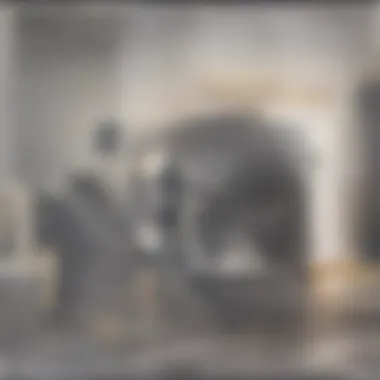A Comprehensive Guide to Cleaning Your Dishwasher


Intro
Keeping your dishwasher clean is essential for maintaining its longevity and efficiency. When neglected, a dishwasher can develop unpleasant odors, clogged filters, and ineffective cleaning cycles. This guide provides practical insights into effective cleaning techniques, tools, and maintenance tips. It is for anyone who relies on this appliance to keep their kitchen running smoothly.
In this comprehensive guide, we will explore the key areas that need attention, methods for deep cleaning, and strategies to prevent future build-up. Understanding these aspects will not only enhance your dishwashing experience but also prolong your dishwasher's lifespan.
Feature Spotlight
Cleaning Cycle Efficiency
A dishwasher operates optimally when clean. Food particles and grease accumulate over time, obstructing arms and spray jets. Regular cleaning ensures these components function correctly, enhancing the overall efficiency of the cycle. Many users overlook this aspect, focusing only on surface cleanliness.
Rinse and Filter Maintenance
The filter is a crucial aspect of your dishwasher's functionality. If it remains dirty, it will hinder the machine’s ability to clean efficiently. Most dishwashers come with removable filters that should be cleaned regularly. It is usually a simple process involving removing the filter and rinsing it under hot water. An organized cleaning schedule can help in maintaining the filter and ensuring optimal performance.
Key Cleaning Techniques
Step-by-Step Cleaning Process
- Empty the Dishwasher: Ensure that no dishes remain inside before cleaning.
- Remove and Clean the Filter: Take out the filter for thorough washing.
- Wipe Down the Interior: Use a soft cloth or sponge to remove grime from the walls and door.
- Check and Clean Spray Arms: Remove the spray arms and clean any blockages.
- Run a Cleaning Cycle with Vinegar: Pour a cup of white vinegar into a container placed on the top rack and run a hot cycle.
- Deodorize with Baking Soda: For a fresh scent, sprinkle baking soda on the bottom and run a short hot cycle.
Preventative Maintenance Tips
- Regularly Check the Seal: Wipe down the rubber seal around the door to ensure a good seal.
- Avoid Overloading: Overloading can block spray jets and lead to ineffective cleaning.
- Use Quality Detergent: Choose a detergent that is effective and compatible with your machine.
Ending
Cleaning your dishwasher is not just about aesthetics. It plays a significant role in how well your appliance functions over time. By implementing these techniques and maintenance tips, you can ensure your dishwasher remains in top condition. Over time, these practices will enhance its performance and extend its service life.
"A clean dishwasher is not just a luxury; it is essential for effective dishwashing and appliance longevity."
Regular cleaning and maintenance are worthwhile investments for any homeowner.
Understanding Your Dishwasher
Understanding the anatomy and function of your dishwasher is crucial for effective cleaning and maintenance. A dishwasher is not just a device; it is a sophisticated appliance designed to streamline the dish-cleaning process. Familiarizing yourself with how it operates lays the groundwork for not only better cleaning habits but also prolongs the life of the machine.
When you comprehend the specific components of your dishwasher, you can identify the areas requiring attention during cleaning. This knowledge provides a clearer perspective on how food particles and other residues accumulate and where blockages may arise. Additionally, knowing your dishwasher helps in troubleshooting common problems that can occur, thus enabling you to act swiftly and efficiently.
Moreover, a well-maintained dishwasher operates optimally, consuming less water and energy. This efficiency is beneficial not only from an environmental standpoint but also translates into cost savings on utilities. Ultimately, understanding the dishwasher enhances your overall dishwashing experience, as a clean machine delivers cleaner dishes.
Basic Components of a Dishwasher
Every dishwasher has several key components that work together seamlessly:
- Spray Arms: These rotating arms spray water throughout the interior, ensuring that all dishes receive an adequate wash.
- Filter: The filter traps food particles and debris, preventing them from recirculating during the wash cycle.
- Heating Element: This component heats the water to the necessary temperatures for effective cleaning.
- Detergent Dispenser: It releases cleaning agents at the right moment during the cycle.
- Pump: The pump circulates water and drains it out after a wash.
- Door Seal: This prevents water from leaking during operation, maintaining efficiency.
Each of these components plays a vital role in how well your dishwasher performs its cleaning tasks. Recognizing these parts allows you to approach cleaning and maintenance more strategically.
Common Issues Leading to a Need for Cleaning
Several factors contribute to the need for regular cleaning of your dishwasher:
- Accumulation of Food Particles: Leftover food can clog filters and spray arms.
- Hard Water Buildup: Minerals in hard water can form deposits, leading to reduced efficiency.
- Odors: A buildup of food and grease can lead to unpleasant smells emanating from the appliance.
- Blocked Drain: Food debris can cause the drain to become clogged, leading to water pooling.
- Ineffective Cleaning: If dishes are coming out dirty or with spots, it may indicate a need for thorough cleaning.


Addressing these common issues promptly can improve the performance of your dishwasher, ensuring it remains a reliable ally in your kitchen.
Preparation for Cleaning
Preparation is a crucial step when it comes to cleaning your dishwasher. Proper preparation ensures that the entire process is efficient and effective. By gathering the right tools and understanding safety measures, you can make the cleaning task simpler and safe. Without this prep work, you may encounter problems that waste time and could lead to potential damage.
Gathering Required Tools and Supplies
Before starting, it is vital to collect tools and supplies needed for the task. This preparation will allow for a smooth cleaning process. Consider including:
- Dishwasher-safe cleaner: Look for products that are specifically formulated for dishwashers. Avoid harsh chemicals that could damage the appliance.
- Soft cloths or sponges: Use these for wiping surfaces inside and outside as they can clean effectively without scratching.
- Brushes: A small, soft brush can help reach tight spaces like spray arms or around the filter area.
- Vinegar: A natural option for cleaning, it helps in removing hard water stains and odors.
- Baking soda: Another natural cleaner, it can also assist in neutralizing odors.
By having these items ready, you will save time and ensure that every part of the dishwasher is properly cleaned.
Safety Precautions to Consider
Safety should be a priority in any cleaning task. Dishwashers contain various parts that, if mishandled, could cause injuries. Here are essential safety considerations:
- Unplug the Dishwasher: Always disconnect the power supply before conducting any cleaning. This prevents accidental shocks.
- Wear Gloves: Protect your hands from cleaners and any potential sharp edges within the dishwasher.
- Read Manuals: Each dishwasher model may have specific advice regarding cleaning and maintenance. Familiarizing yourself with the manual ensures that you avoid any incorrect procedures.
- Ventilation: Ensure the area is well-ventilated when using cleaning products to avoid inhaling fumes.
Being aware of safety measures keeps you safe and prevents damage to your appliance.
By preparing well before diving into the cleaning process, you lay a solid foundation for achieving an optimal result.
Initial Inspection of the Dishwasher
Performing an initial inspection of your dishwasher is a crucial step before diving into the cleaning process. This phase sets the stage for effective maintenance, ultimately enhancing the appliance's longevity and performance. When you understand the internal conditions of your dishwasher, you can address issues proactively. This section emphasizes why initial inspection is vital and delves into two key areas: filter removal and blockage checks.
Removing and Inspecting the Filter
The filter is an essential component of your dishwasher. It prevents food particles and debris from circulating back into your clean dishes. To maintain optimal performance, it is crucial to remove and inspect this filter regularly.
Start by consulting your dishwasher's manual for specific instructions. Usually, filters can be found at the bottom of the dishwasher. After locating the filter, take it out gently. Inspect for any visible buildup or clogs. An excessively dirty filter not only hinders performance but can cause odors. Clean the filter under warm running water using a soft brush for removing stubborn residue. You must ensure the filter is dry before replacing it. Doing so will help maintain a cleaner wash cycle and prevent unwanted odors.
Checking for Blockages
Blockages can severely impact your dishwasher's efficiency. After filtering, it’s prudent to check the spray arms and drain. Begin by observing the spray arms; they should rotate freely. If you notice any obstructions, like food remnants or hard water deposits, remove these blockages. You can soak the spray arms in a vinegar solution to dissolve mineral buildup.
Next, inspect the drain area for any obstructions. If the drain is blocked, water cannot exit efficiently, affecting wash cycles. Clearing blockages can often resolve water drainage issues, enhancing performance. It is valuable to inspect drainage hoses periodically for kinks or damage as well. Doing these checks can considerably improve your dishwasher's functionality, making future cleaning sessions easier and more effective.
Regular initial inspections lead to improved appliance lifespan and efficiency.
By undertaking these initial steps, you can ensure your appliance runs smoothly. Maintaining regular inspections not only improves performance but also extends the life of your dishwasher. These actions are simple yet essential steps to better dishwashing experiences.
Deep Cleaning the Interior
Deep cleaning the interior of your dishwasher is an essential step that often gets overlooked. While regular maintenance may keep your machine functional, accumulated grime and residue can greatly reduce efficiency. A clean interior not only enhances performance but also eliminates unpleasant odors that might taint your dishes. By dedicating time to thorough cleaning, you can prolong the lifespan of your appliance and ensure optimal functionality.
Wiping Down the Walls and Door
When wiping down the walls and door of your dishwasher, it is crucial to use a soft cloth or sponge along with a mild detergent. Start by ensuring the appliance is turned off. Use warm, soapy water to thoroughly clean the walls, paying close attention to any buildup or stains. It is common for food particles to cling to the interior surfaces. Make sure to clean the rubber seals around the door; this is where mold and mildew can develop if not wiped regularly.
After washing, rinse with clean water to remove any soap residue. Dry the surfaces with a clean, dry cloth. Regularly wiping down your dishwasher will help maintain a fresh and hygienic environment, preventing the development of stubborn residues.
Cleaning the Spray Arms


The spray arms are pivotal in ensuring effective cleaning during operation. They distribute water throughout your dishes, making it imperative to keep them clear of blockages. To clean the spray arms, first, remove them according to your manufacturer’s guidelines. Check for any food debris that may be clogging the holes and use a toothpick or a small brush to dislodge any buildup.
After removing debris, rinse each spray arm under running water to clear any remnants. Reattach the spray arms to their respective positions once dry. This step is vital for maintaining efficient wash cycles and ensuring that your dishes come out clean every time.
Descaling the Dishwasher
Descaling your dishwasher is not just about aesthetics; it plays a significant role in enhancing the machine's performance. Over time, mineral deposits can accumulate, especially in areas with hard water. These deposits can hinder the appliance's ability to wash effectively and reduce its lifespan. To descale your dishwasher, you can use a commercial descaling agent or a simple mixture of vinegar and baking soda.
Pour the vinegar into a dishwasher-safe container and place it on the top rack. Run a normal wash cycle without any dishes. After this cycle, sprinkle baking soda along the bottom of the dishwasher and run a short cycle. This process will help dissolve any accumulated scale and leave your dishwasher smelling fresh. Regular descaling will improve performance and help mitigate issues related to water hardness.
Cleaning the Exterior
Cleaning the exterior of your dishwasher is as important as maintaining its interior. A clean exterior not only enhances the appliance's aesthetic but also helps in preventing corrosion and wear over time. The exterior surfaces often get dirt, grease, and fingerprints that can accumulate and become unsightly. Regular maintenance of these surfaces can significantly improve the overall longevity of the appliance.
Cleaning the Control Panel
The control panel is the nerve center of your dishwasher. It provides vital information and allows users to select different washing cycles. Keeping this area clean is essential. Use a soft, damp cloth to gently wipe the buttons and display. Avoid aggressive scrubbing as it may damage the labels or the functionality of the buttons. For persistent stains, consider using a gentle soap solution. Always ensure that the dishwasher is off to avoid any accidental activation while cleaning.
- Importance: A clean control panel ensures smooth operation and prevents malfunctions.
- Considerations: Use non-abrasive cleaners to avoid scratching the surface.
Polishing the Outer Surface
Polishing the outer surface of the dishwasher can give it a fresh look. Depending on the material, you may need to use specific cleaning solutions. Stainless steel surfaces often smudge easily and require regular polishing to maintain their shine. Products designed specifically for stainless steel are usually very helpful. Apply the cleaner with a microfiber cloth. Work with the grain of the material for the best results.
- Select the Right Cleaner: Choose a cleaner suitable for the material of your dishwasher.
- Application Method: Apply gently and buff to a shine.
- Frequency: Regular polishing keeps surfaces looking new and enhances their resistance to stains.
Keeping the dishwasher exterior spotless not only improves its appearance but also helps maintain a hygienic kitchen environment.
Maintenance Tips for Optimal Performance
Regular maintenance is key to ensuring your dishwasher operates smoothly and efficiently. Knowing how to maintain your appliance effectively can prolong its lifespan and enhance its performance. Maintenance not only prevents build-up but also aids in avoiding potential malfunctions. By dedicating a small amount of time to maintain your dishwasher, you can save both energy and water in the long run. Here are some specific elements to focus on when it comes to maintenance tips for optimal performance.
Regular Inspection Schedule
Establishing a regular inspection schedule is crucial. Aim to inspect your dishwasher every month for any signs of wear or potential issues. During your inspections, pay close attention to the following:
- Filter Condition: A clogged filter can hinder performance. Remove and clean it monthly.
- Spray Arm Operation: Ensure that spray arms can rotate freely. Blockages can occur due to food particles or utensil positioning.
- Gaskets: Regularly examine the door gaskets for any signs of deterioration.
Setting a reminder on your calendar can help you stay on track with your inspections.
Recommended Cleaning Products
The right cleaning products can significantly enhance the effectiveness of your maintenance efforts. Consider using the following:
- Vinegar: A natural cleaning agent that helps to remove mineral deposits and eliminate odors.
- Baking Soda: An excellent product to use for deodorizing and some surface cleaning tasks.
- Dishwasher Cleaner Tablets: These specialty products are designed to target build-up inside the appliance.
Ensure that you choose products that are safe for your specific model to avoid any damage. Always check the manufacturer's recommendations for compatible cleaners.
Best Practices for Loading Dishes
Loading your dishwasher properly is a simple yet effective maintenance practice. Incorrect loading can lead to poor cleaning results and increased wear on the appliance. Follow these best practices when loading your dishwasher:
- Place Large Items on the Bottom Rack: Ensure that larger pots and pans do not block the spray arms.
- Face Plates and Glasses Downward: Facing items downward allows water to reach all surfaces effectively.
- Avoid Overloading: Too many dishes can create blockages and prevent clean water from circulating.
Implementing these best practices will maximize cleaning efficiency and maintain optimal performance over time.


Troubleshooting Common Problems
Cleaning a dishwasher is critical not only for maintaining its efficiency but also for ensuring that dishes come out spotless. In this section, we will tackle common issues that arise and discuss effective troubleshooting techniques. This is vital for restoring the appliance’s functionality and preventing future problems. Understanding these issues can save users both time and money.
Identifying Odor Issues
Odor problems in dishwashers often arise due to food debris and grease buildup. Leftover food particles can decay or mold, leading to unpleasant smells. First, it's essential to check the drain and filter area.
Steps to identify and resolve odors:
- Inspect the filter for leftover food.
- Look for any stagnant water in the bottom of the appliance.
- Smell check: Open the dishwasher before running a cycle to catch any lingering scent.
If odors persist, consider running an empty cycle with white vinegar. The acidity helps eliminate odors without harsh chemicals.
"Regular maintenance and cleaning can significantly reduce the likelihood of odor issues in your dishwasher."
Understanding Poor Wash Performance
A dishwasher that does not clean properly can be frustrating. This may stem from multiple factors, including clogged spray arms or incorrect loading.
To diagnose poor wash performance, follow these steps:
- Check spray arms: Ensure they are not clogged or obstructed. Food particles can block the holes, limiting water flow.
- Inspect the detergent compartment: Ensure it is dispensing detergent correctly during the wash cycle.
- Evaluate water temperature: Water should be hot enough to dissolve detergent effectively.
By systematically checking these areas, you can often isolate the source of wash performance issues and restore functionality.
Addressing Water Drainage Problems
Water drainage issues can lead to standing water in your dishwasher. It can cause odors and even potential damage over time.
To address drainage problems, consider the following:
- Inspect the drain hose: Ensure it is not kinked or clogged. Sometimes, food debris can block the hose, preventing proper drainage.
- Clear the filter: A clogged filter impedes water flow. Remove it and clean any debris.
- Run a cleaning cycle: Use a dishwasher cleaning product to help flush any remaining debris.
By addressing drainage issues promptly, you can enhance your dishwasher’s performance and longevity.
When to Call a Professional
Understanding when to engage a professional for dishwasher issues is crucial for maintaining the appliance's efficiency and longevity. Some problems may appear minor but can signify significant underlying issues. Evaluating these signs promptly can help prevent extensive damages and additional costs.
Signs of Major Issues
Several indicators suggest that your dishwasher requires professional intervention. Recognizing these early can make a difference.
- Persistent Odors: If unpleasant smells linger even after cleaning, this can indicate hidden food debris or mold growth.
- Water Accumulation: Standing water at the bottom of the machine after a cycle is a sign of drainage problems that might not be an easy fix.
- Unusual Noises: If your dishwasher produces strange noises during operation, it may indicate a mechanical failure.
- Leaking Water: Any water pooling outside the machine is serious and indicates seal or hose issues.
- Failure to Start: If the dishwasher does not respond to commands, this could be an electrical problem that needs professional diagnosis.
If you notice any combination of these issues, consider calling a service technician. They possess the expertise to diagnose and fix problems safely and efficiently.
Comparison of DIY vs Professional Solutions
When faced with dishwasher issues, many homeowners wonder whether they should tackle repairs themselves or hire a professional. Their decision can impact both time and money.
DIY Solutions:
- Cost-effective: Attempting to fix minor issues yourself can save money.
- Basic Repairs: Simple fixes, like cleaning the filter or spray arms, are often manageable.
- Learning Experience: With guidance, you can gain knowledge about your appliance.
Professional Solutions:
- Comprehensive Inspections: Professionals can identify problems that may not be evident to an untrained eye.
- Safety: Certain repairs involve electrical work that can be dangerous without proper knowledge.
- Warranty Considerations: Repairing issues yourself might void warranties, while professionals typically ensure compliance with service agreements.
In summary, while some issues lend themselves well to DIY solutions, complex problems often necessitate professional help. Make a wise choice based on the severity of the situation to protect your investment and ensure the optimal performance of your dishwasher.







